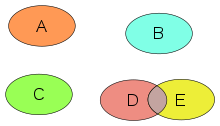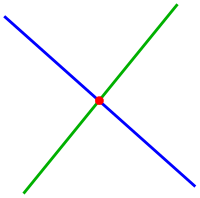Intersection



수학(mathematics)에서, 두 개 이상의 대상의 교차(intersection)는 동시에 모든 대상에 포함된 모든 것으로 구성된 또 다른 대상입니다. 예를 들어, 유클리드 기하학(Euclidean geometry)에서, 평면(plane)에서 두 직선(lines)이 평행하지 않을 때, 그것들의 교차점은 두 직선이 만나는 점(point)입니다. 보다 일반적으로, 집합 이론(set theory)에서, 집합의 교집합은 그것들의 모두에 속하는 원소(elements)의 집합으로 정의됩니다. 유클리드 정의와 달리, 이것은 고려 중인 대상이 공통 공간(space)에 있다고 가정하지 않습니다.
교차점은 기하학(geometry)의 기본 개념 중 하나입니다. 교차점은 다양한 기하학적 모양(geometric shapes)을 가질 수 있지만, 점(point)은 평면 기하학(plane geometry)에서 가장 공통적입니다. 투사 기하학(Incidence geometry)은 각 원래 대상에 투사(incident)인 더 낮은 차원(dimension)의 대상으로 (보통, 플랫의) 교차점을 정의합니다. 이 접근 방식에서, 교차점은 평행 직선(parallel lines)과 같이 때때로 정의되지 않을 수 있습니다. 두 경우 모두에서, 교차의 개념은 논리곱(logical conjunction)에 의존합니다. 대수적 기하학(Algebraic geometry)은 교차 이론(intersection theory)과 함께 고유한 방법으로 교차를 정의합니다.
Uniqueness
교차를 형성하는 점 (위 그림 참조)과 같은 원시 대상이 두 개 이상 있을 수 있습니다. 교차는 모든 공유된 대상 (즉, 교차 연산은 집합을 초래함, 빈 것도 가능), 또는 여러 교차 대상 (영도 가능)으로 집합적으로 볼 수 있습니다.
In set theory

두 집합 A와 B의 교집합은 A와 B 모두에 있는 원소의 집합입니다. 형식적으로,
- .[1]
예를 들어, 만약 와 이면, 입니다. 더 정교한 예제 (무한 집합을 포함)는 다음과 같습니다:
- A = {x is an even integer}
- B = {x is an integer divisible by 3}
또 다른 예제로, 숫자 5는 소수 집합 {2, 3, 5, 7, 11, ...}과 짝수 집합 {2, 4, 6, 8, 10, ...}의 교집합에 포함되지 않는데, 왜냐하면 5는 소수이지만 짝수가 아니기 때문입니다. 사실, 숫자 2는 이들 두 집합의 교집합에 있는 유일한 숫자입니다. 이 경우에서, 교집합은 수학적 의미를 가집니다: 숫자 2는 유일한 짝수 소수입니다.
In geometry
기하학(geometry)에서, 교차(intersection)는 (직선, 곡선, 평면, 및 표면과 같은) 둘 이상의 대상에 공통적인 점, 직선, 또는 곡선입니다. 유클리드 기하학(Euclidean geometry)에서 가장-간단한 경우는 두 구별되는 직선(lines)이 교차하는 것이며, 그것은 하나의 점(point) 또는 만약 직선들이 평행(parallel)하면 존재하지 않는 것 중 하나입니다.

Notation
교차점은 유니코드 수학 연산자(Unicode Mathematical Operators)의 U+2229 ∩ INTERSECTION에 의해 표시됩니다.
기호 U+2229 ∩ 는 1844년 Die Ausdehnungslehre von에서 헤르만 그라스만(Hermann Grassmann)에 의해 교집합에 특화되지 않은 일반 연산 기호로 처음 사용되었습니다. 거기에서, 그것은 주세페 페아노(Giuseppe Peano) (1858-1932)에 의해 1888년 Calcolo geometrico secondo l'Ausdehnungslehre di H. Grassmann에서 교집합에 대해 사용되었습니다.[2][3]
페아노는 역시 그의 1908년 책 Formulario mathematico에서 두 개 이상의 클래스의 일반적인 교집합과 합집합(union)에 대한 큰 기호를 만들었습니다.[4][5]
See also
- Constructive solid geometry, Boolean Intersection is one of the ways of combining 2D/3D shapes
- Dimensionally Extended 9-Intersection Model
- Meet (lattice theory)
References
- ^ Vereshchagin, Nikolai Konstantinovich; Shen, Alexander (2002-01-01). Basic Set Theory. American Mathematical Soc. ISBN 9780821827314.
- ^ Peano, Giuseppe (1888-01-01). Calcolo geometrico secondo l'Ausdehnungslehre di H. Grassmann: preceduto dalle operazioni della logica deduttiva (in Italian). Torino: Fratelli Bocca.
- ^ Cajori, Florian (2007-01-01). A History of Mathematical Notations. Torino: Cosimo, Inc. ISBN 9781602067141.
- ^ Peano, Giuseppe (1908-01-01). Formulario mathematico, tomo V (in Italian). Torino: Edizione cremonese (Facsimile-Reprint at Rome, 1960). p. 82. OCLC 23485397.
- ^ Earliest Uses of Symbols of Set Theory and Logic
External links





